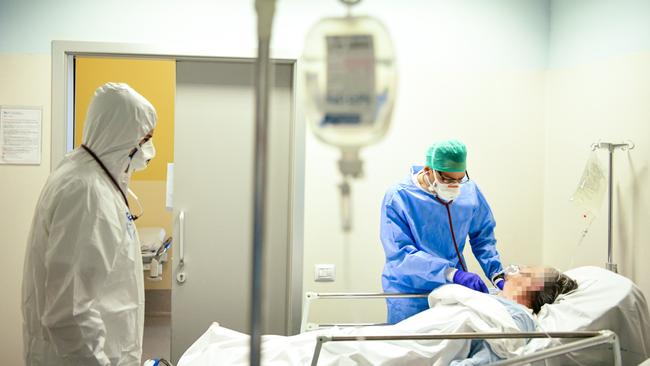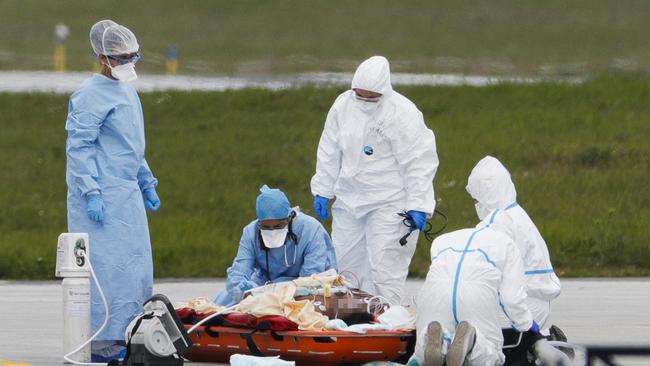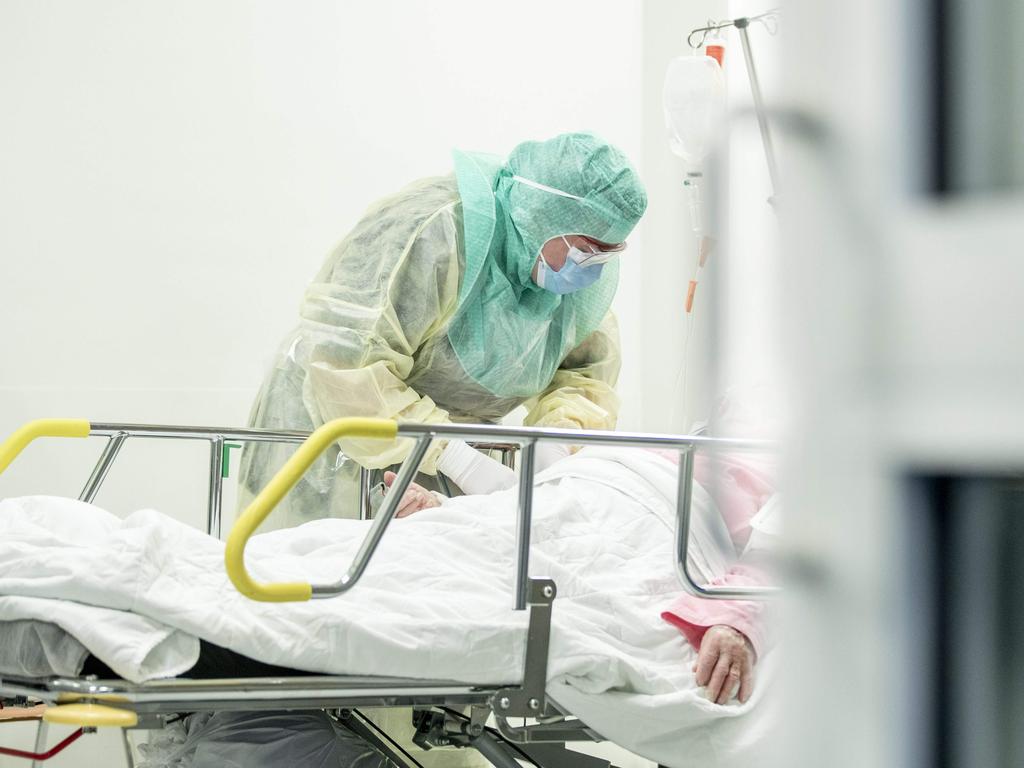Coronavirus: What COVID-19 does to your body
It comes as a wolf in sheep’s clothing, tricking the body’s cells. Here’s what we know about the invisible killer.

DAY 0: INFECTION
You will never know the particular virus that gets you. It may come from someone who knows they are infectious. It may come from someone who has yet to have had even a cough. It may be blown in the air, hitching a ride on a tiny droplet of exhaled breath. It may be propelled by a sneeze, a free-rider on a turbo-charged splatter of mucus. Or it may come from a surface that you idly touch and then not long after, perhaps with an absent-minded scratch, idly spread to your face. All it needs is a way in.
Viruses are unimaginably small - quite literally. They are smaller than the human brain is built to conceive. We think of cells as small. A virus, that infects a cell, is a millionth its volume. These are packets of protein, not exactly live but not exactly dead, that exist at the threshold between the atomic world and the world of the animal. At 90 nanometres long, if you laid 1,000 coronaviruses end to end, they would span a human hair. If you packed a couple of trillion together, they would fill a pinhead.
A virus is not a bacterium. It is far smaller, for a start. But the crucial difference is that, more than any parasite or microbe, it needs you.
Bacteria can survive outside you. They can multiply in the warmth and wet.
Viruses need cells to propagate. Without the truly living, they are nothing.
So the instant they leave a body, the clock is ticking. In the air, the World Health Organisation advises that they are unlikely to last long. Stay two metres from someone and you are probably safe. The emphasis, though, is on the word “probably”. American scientists deliberately sprayed an aerosol of the virus into the air and found that it was infectious three hours later.
On surfaces it could last longer. The same scientists applied viruses to a variety of different materials. On all of them the half life - the time for half the viruses to degrade - was measured in hours. On plastic and stainless steel, of the kind that looks so hygienic in public toilets, viable virus was still found three days later. On cardboard, nothing lasted a day. Newspapers should be fine because the ink kills the virus.
Most things, in fact, kill the virus. If it were not for the fact that we shed so many of them, they would never spread at all - the delicate fatty layer surrounding the protein degrades too easily. But viruses know this, and they go for quantity over quality.
Quite how much quantity was clear when scientists from the University of Nebraska Medical Center decided to study a Covid-19 ward. They sampled the air and swabbed the surfaces.
Even here, with hygiene a priority, the coronavirus was everywhere. On iPads and reading glasses, books and exercise equipment, it was ubiquitous - 80 per cent of personal items tested positive. The same was true of surfaces in the rooms, from bedrails to bedside tables. Wafting and floating, the virus had invisibly occupied the whole floor - and could be found in two thirds of air samples taken in the hallway outside.
DAY 1: REPLICATION
the virus is nothing without you. From the moment it enters your body, it must infect to survive. It must find a cell, fool it, and then hijack its genetic apparatus for its own ends. And from the point of view of a virus, only one end matters: it needs to copy itself. It needs to make so many copies of itself, so fast, in fact that it can evade your immune system and spread to someone else. Because, eventually, its time in our body will end. It will end because you kill it, or it will end because it kills you. Both results are equally bad for a virus that needs the living to survive.
Coronaviruses are so named because, at least when first observed, they look a bit like a crown. Around the sphere at its centre are spiky bits of protein, poking out in a corona. These spikes are what, eventually, your immune system will learn to spot. Until that happens, one of them is the virus’s entree to your cells.
At the point of entry, perhaps in your nostril, one of those spikes fits inside a receptor on a cell, like a lock in a key. And, just like a key, it opens the door. The virus is inside, and it is about to take control.
A coronavirus does not have DNA, it has RNA - a different, but closely related, genetic material. In our bodies, RNA transfers instructions from DNA, to make the proteins that keep us going. That is what this RNA is about to do. Except what it is going to make is more virus.
Once inside the cell, the RNA confuses it. All its apparatus, its molecular machines, are set up to assume that RNA is a message from the DNA at its core, telling it what to do. So this cellular production line obeys instructions and starts churning out bits of virus. The cell has become a workshop for spreading the infection that could become its undoing.

DAY 5: INCUBATION
average incubation period, the time taken from infection to showing symptoms, is five days. It can, however, be as little as two days or as long as 14.
symptoms: A coronavirus comes as a wolf in sheep’s clothing. Some deadly viruses are easy to spot. Ebola is rightly feared, in part because the symptoms are so horrific. In extremis, people bleed from their eyes. But that horror is also its undoing. A virus that is so visible cannot stay hidden for long.
Coronaviruses, though, are different. All of us have had the cousin of this particular virus in the past. A third of common colds are caused by one coronavirus or another. And, for a while, that is how this new virus appears. We all know the symptoms. A cough, a fever, tiredness, headache, shortness of breath. Most - unlike with colds - won’t get a runny nose.
But, even then, some will. Many will lose their sense of smell and taste entirely. For 80 per cent of people that will be it. Coronavirus, for them, will be a bad cold. For about 20 per cent, though, it will get a lot worse.
DAY 14: ADMITTED TO HOSPITAL
about a week after symptoms begin, most people are over the illness. For some people, though, this is when they reach the point when they need to go to hospital.
how the virus spreads: There is a physiological reason why you cough when you have a cold. It is because you need to bring up phlegm. There is another reason though, not contradictory to the first. It is because the virus wants you to cough.
Viruses that learnt, by chance, how to make animals cough were more likely to spread than other viruses. So that talent was conserved by evolution, and incorporated into their suite of behaviour.
When you cough you are also doing something else: you are raising the virus’s reproduction number, R0. The reproduction number is the crucial determinant of its success. It is the number of extra people each newly infected person passes it on to. If it is more than 1, a virus proliferates.
If you had been infected before the lockdown measures came into place, then R0 will have been about 3. During the time you were infectious, through a mixture of coughing and carelessness, you would have on average infected three other people.
Today (Saturday), in every country in the world, public health measures are now being enacted with one goal - the only goal that matters in quashing a pandemic: bringing the reproduction number below 1.
DAY 14 ON: INFECTION ENDS
the symptoms have stopped and, probably, you are no longer infectious. Within your body there is probably a strong cohort of antibodies, each with a structure that automatically latches on to coronavirus, flagging it for destruction.
Probably, these antibodies will stay in your immune system for many months, and ideally years, to come.
For now, though, as more of us move from - to use the epidemiological modelling terms - “susceptible” to “recovered”, all we have is “probably”. And given how much rides on it, we should all hope those “probablies” end up being certainties.
DAY 27: DEATHS
at the very end, the enemy may not be the virus but yourself. Your immune system is a powerful and complex machine. The product of billions of years of evolution, of an invisible arms race with unseen and unseeable enemies, it can adapt, in theory, to any pathogen.
This time last year, no human on earth had been exposed to this coronavirus - no antibody had been built to latch on to it. This time next year in hundreds of millions, possibly billions, of people, immune systems will have independently developed a response. In the blood of humans around the world there will be antibodies, y-shaped bits of protein, circulating and waiting. On the end of each “y” will be a template, a negative 3D image of a corresponding protein on the coronavirus. They will lie dormant, ready to leap on anything that looks like Covid-19, and flag it for destruction.

But, sometimes, complex systems go wrong. In the miraculous process of developing these antibodies, and fielding the first, cruder, defences, there are feedback loops. There are first-line responders, there are - to extend the metaphor - overzealous troops.
When your body spies an infection, it releases chemical messengers called cytokines, that call in reinforcements and co-ordinate a response.
Sometimes, it overreacts. In the body’s rush to send in defensive cells, blood vessels can overload. Fluid can leak into the lungs. Pneumonia develops: people stop being able to breathe for themselves.
Elsewhere, with the immune system going into overdrive, it can start attacking the wrong things. Bacteria can find their way in and secondary infections result. The body starts to break down. If it was already weakened - if other organs were already in trouble - then there are more places where that breakdown can become a total failure.
This response is called a cytokine storm, and it is almost certainly behind the most severe cases. It is also the reason that, in what was once a conference centre in the London Docklands, 4000 beds lie waiting.
The Times







To join the conversation, please log in. Don't have an account? Register
Join the conversation, you are commenting as Logout